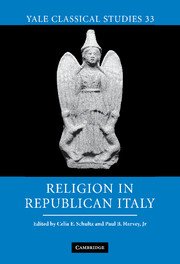Book contents
- Frontmatter
- Contents
- List of illustrations
- List of contributors
- Acknowledgments
- List of abbreviations
- Introduction
- Chapter 1 Reconsidering “religious Romanization”
- Chapter 2 In search of the Etruscan priestess: a re-examination of the hatrencu
- Chapter 3 Etruscan religion at the watershed: before and after the fourth century bce
- Chapter 4 Religious locales in the territory of Minturnae: aspects of Romanization
- Chapter 5 Religion and memory at Pisaurum
- Chapter 6 Inventing the sortilegus: lot divination and cultural identity in Italy, Rome, and the provinces
- Chapter 7 Hot, cold, or smelly: the power of sacred water in Roman religion, 400–100 bce
- Chapter 8 Religion and politics: did the Romans scruple about the placement of their temples?
- Chapter 9 Juno Sospita and Roman insecurity in the Social War
- Chapter 10 Beyond Rome and Latium: Roman religion in the age of Augustus
- Bibliography
- Index
Chapter 8 - Religion and politics: did the Romans scruple about the placement of their temples?
Published online by Cambridge University Press: 08 January 2010
- Frontmatter
- Contents
- List of illustrations
- List of contributors
- Acknowledgments
- List of abbreviations
- Introduction
- Chapter 1 Reconsidering “religious Romanization”
- Chapter 2 In search of the Etruscan priestess: a re-examination of the hatrencu
- Chapter 3 Etruscan religion at the watershed: before and after the fourth century bce
- Chapter 4 Religious locales in the territory of Minturnae: aspects of Romanization
- Chapter 5 Religion and memory at Pisaurum
- Chapter 6 Inventing the sortilegus: lot divination and cultural identity in Italy, Rome, and the provinces
- Chapter 7 Hot, cold, or smelly: the power of sacred water in Roman religion, 400–100 bce
- Chapter 8 Religion and politics: did the Romans scruple about the placement of their temples?
- Chapter 9 Juno Sospita and Roman insecurity in the Social War
- Chapter 10 Beyond Rome and Latium: Roman religion in the age of Augustus
- Bibliography
- Index
Summary
INTRODUCTION: CICERO AND CLODIUS
It is commonplace now to find political explanations for the many building projects of the late Republic and empire. Yet the application of similar explanations to earlier periods in the Republic has been limited. This chapter aims to correct this situation in part by looking at a series of projects from the years around 300 bce. First we will examine the politicized nature of various building types at the end of the Republic and how Romans believed that this political aspect of building had been present from early on.
For great men in the final decades of the Republic, temple construction had become part of the arsenal of political competition. For example, Pompey dedicated the Temple of Venus Victrix in 55, only to have it met in 46 by Caesar's Venus Genetrix. Neither project was limited to sacred space: both included other amenities and meeting places for the Senate. Perhaps the best example of the politically motivated dedication of a temple is the one described by Cicero in his post-exile oration De Domo Sua, which he delivered in 57 bce, before the pontifices and numerous other religiously and politically powerful Romans. In that speech, Cicero memorably put forward his arguments for regaining his house and property on the Palatine from its recent conversion to a temple of the goddess Libertas by the machinations of his nemesis, P. Clodius Pulcher.
- Type
- Chapter
- Information
- Religion in Republican Italy , pp. 181 - 206Publisher: Cambridge University PressPrint publication year: 2006
- 4
- Cited by



